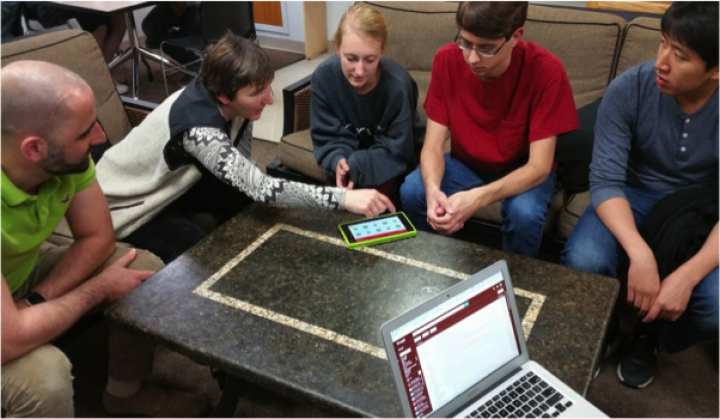Code for the Cure: Using Classroom Driven Research to Solve Real-world Problems
The University of Maryland strives to conduct leading research in state of the art laboratories throughout campus. However, as required skillsets for jobs in STEM grows, upper-level undergraduate students in the Department of Computer Science are finding new opportunities to learn research skills inside of the classroom while applying them to real-world problems.
In Professor Atif Memon's Programming Handheld Systems class, offered as CMSC436, 83 undergraduate students worked with scientists from the National Institutes of Health (NIH) to develop a comprehensive suite of apps to improve remote diagnosis and monitoring of patients diagnosed with multiple sclerosis. CMSC 436 is a mobile application development course focused on software solutions for Google’s Android platform.
Led by Professor Atif Memon of the Computer Science Department and Dr. Bibiana Bielekova of National Institutes of Health, students worked in product teams to create new mobile neurological tests designed for patients with Multiple Sclerosis using fairly accessible technology. Patients are able complete these tests in the comfort of their homes, which may eliminate the need for extra visits to physicians. These type of tests may also promote affordable and accessible health care. “Medical care is becoming expensive, and many physicians do not have time to regularly perform a complete neurological exam,” said Bielekova. She hopes that these mobile tests will help make treatment options more readily available for patients. These options will also let patients consistently monitor their wellbeing allow them to take more control of their healthcare.
Thanks to the variety of internal sensors built into modern smartphones including acceelrometors, gyroscopes, and near field communication tags, the students were able to build applications to test the dexterity, cognition, precision, and motor skills of target patients. Their tests measure patients' reaction time by having them tap on randomly appearing bubbles on a mobile device; measure fine motor skills by having patients accurately trace a spiral shape on the screen; measure gait and movement speed to monitor a patient’s mobility. The results from these tests allow doctors to detect trends about a patient's progressive diagnosis with accuate, current data. So far the app has been tested successfully on a variety of smartphones.
As a patient completes tests, the results are automatically stored within a central database accessed by the patient’s physician. This allows a doctor the ability to quickly and easily evaluate trends and progress remotely, without a patient needing to travel outside of their own home.
Senior Michelle Cody said, “I enjoy applying real world computer science skills to a tangible user experience that will help others in some greater capacity.” Unlike many computer science courses that feature individual project assignments, students regularly work in their product teams and learn more than the required technical skills. Memon believes that teamwork will allow students to be more readily prepared for the real-world, where soft skills and strong communication skills are equally important when working in large software engineering teams.
Moving forward, CMSC436 students will continue to work with Dr. Bielekova to optimize testing procedures and metrics in order to provide the highest possible accuracy and practicality for both doctors and their patients. Students will also be able to participate in extended research opportunities associated with this project throughout the academic year.
Article written by Jeremy Krach and Christian Johnson
The Department welcomes comments, suggestions and corrections. Send email to editor@cs.umd.edu.
